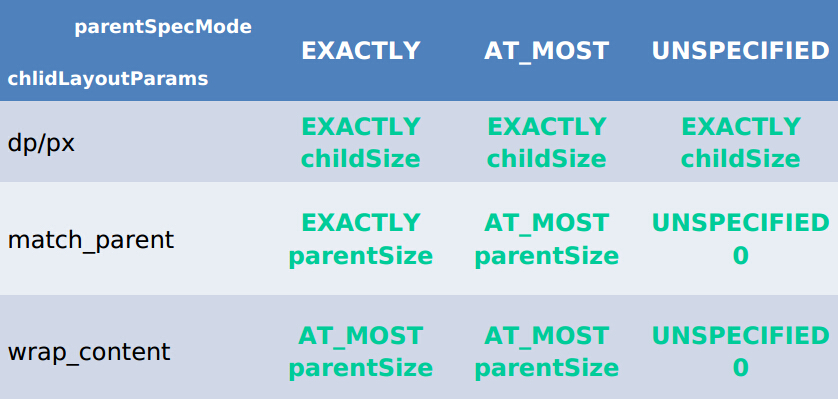一 View的绘制过程
初识 ViewRoot
ViewRoot 对应于 ViewRootImpl 类,是连接 WindowManager 和 DecorView 的纽带。 ActivityThread 中当 activity 对象被创建好后,会将 DecorView 加入到 Window中同时完成 ViewRootImpl 的创建并建立和 DecorView 的联系。 root = new ViewRootImpl(view.getContext(), display); root.setView(view, wparams, panelParentView); view 的绘制流程从 ViewRoot 的 performTraversals 开始,代码流程是这样的: performMeasure -> measure -> onMeasure performLayout -> layout -> onLayout performDraw -> draw -> onDrawactivity 界面的组成
由下图可知,DecorView作为顶级View,一般情况下它有上下两部分组成(具体情况会和api版本以及Theme有关),上面是title,下面是content,在activity中我们调用setContentView所设置的view其实就是被加到content中,而如何得到content呢,可以这样:ViewGroup group = findViewById(R.android.id.content),如何得到我们所设置的view呢,可以这样:group.getChildAt(0)。同时,通过源码我们可以知道,DecorView其实是一个FrameLayout。这里要说明的一点是View层的大部分事件都是从DecorView传递到我们的view中的。MeasureSpec
MeasureSpec 封装了父容器对 view 的布局上的限制,内部提供了宽高的信息( SpecMode 、 SpecSize ),SpecSize是指在某种SpecMode下的参考尺寸,其中SpecMode 有如下三种: UNSPECIFIED 父容器不对 view 有任何限制,要多大给多大 EXACTLY 父容器已经检测出 view 所需要的大小 AT_MOST 父容器指定了一个大小, view 的大小不能大于这个值 MeasureSpecs 的意义 通过将 SpecMode 和 SpecSize 打包成一个 int 值可以避免过多的对象内存分配,为了方便操作,其提供了打包 / 解包方法MeasureSpec 的实现
MeasureSpec代表一个 32 位 int 值 高 2 位代表 SpecMode ,低 30 位代表 SpecSize
下面先看一下MeasureSpec 内部的一些常量的定义,通过下面的代码,应该不难理解MeasureSpec的工作原理
private static final int MODE_SHIFT = 30;
private static final int MODE_MASK = 0x3 << MODE_SHIFT;
public static final int UNSPECIFIED = 0 << MODE_SHIFT;
public static final int EXACTLY = 1 << MODE_SHIFT;
public static final int AT_MOST = 2 << MODE_SHIFT;
public static int makeMeasureSpec(int size, int mode) {
if (sUseBrokenMakeMeasureSpec) {
return size + mode;
} else {
return (size & ~MODE_MASK) | (mode & MODE_MASK);
}
}
public static int getMode(int measureSpec) {
return (measureSpec & MODE_MASK);
}
public static int getSize(int measureSpec) {
return (measureSpec & ~MODE_MASK);
}
MeasureSpec 与 LayoutParams
对于 DecorView ,其 MeasureSpec 由窗口的尺寸和其自身的LayoutParams 来共同确定 对于应用层 View ,其 MeasureSpec 由父容器的 MeasureSpec 和自身的 LayoutParams 来共同决定 MeasureSpec 一旦确定后, onMeasure 中就可以确定自身的宽高MeasureSpec-DecorView
这里分析下顶级容器DecorView的MeasureSpec的产生过程childWidthMeasureSpec = getRootMeasureSpec(baseSize, lp.width); childHeightMeasureSpec = getRootMeasureSpec(desiredWindowHeight, lp.height); performMeasure(childWidthMeasureSpec, childHeightMeasureSpec);
上述代码描述了DecorView的MeasureSpec的产生过程,为了更清晰地了解,我们继续看下去
private static int getRootMeasureSpec(int windowSize, int rootDimension) {
int measureSpec;
switch (rootDimension) {
case ViewGroup.LayoutParams.MATCH_PARENT:
// Window can't resize. Force root view to be windowSize.
measureSpec = MeasureSpec.makeMeasureSpec(windowSize, MeasureSpec.EXACTLY);
break;
case ViewGroup.LayoutParams.WRAP_CONTENT:
// Window can resize. Set max size for root view.
measureSpec = MeasureSpec.makeMeasureSpec(windowSize, MeasureSpec.AT_MOST);
break;
default:
// Window wants to be an exact size. Force root view to be that size.
measureSpec = MeasureSpec.makeMeasureSpec(rootDimension, MeasureSpec.EXACTLY);
break;
}
return measureSpec;
}
通过上述代码,顶级容器DecorView的MeasureSpec的产生过程就很明确了,具体来说其遵守如下规则:
根据它的LayoutParams中的宽高的参数来分,
LayoutParams.MATCH_PARENT:其模式为精确模式,大小就是窗口的大小
LayoutParams.WRAP_CONTENT:其模式为最大模式,大小不定,但是不能超过窗口的大小
固定大小(比如100dp):其模式为精确模式,大小为LayoutParams中指定的大小
MeasureSpec- 应用层 View
关于应用层View,这里是指我们布局中的view,其MeasureSpec的创建遵循下表中的规则
protected void onMeasure(int widthMeasureSpec, int heightMeasureSpec) {
setMeasuredDimension(getDefaultSize(getSuggestedMinimumWidth(),
widthMeasureSpec),getDefaultSize(getSuggestedMinimumHeight(), heightMeasureSpec));
}
意: 通过 onDraw 派生的 View ,需要重写 onMeasure 并设置 wrap_content 时的自 身大小,否则使用 wrap_content 就相当于用 match_parent 。 原因分析:见上面的表格 那么如何重写onMeasure从而让view支持wrap_content呢?请参看下面的典型代码,需要注意的是,代码中的mWidth和mHeight指的是view在wrap_content下的内部规格,而这一规格(宽高)应该由自定义view内部来指定。
protected void onMeasure(int widthMeasureSpec, int heightMeasureSpec) {
super.onMeasure(widthMeasureSpec, heightMeasureSpec);
int widthSpecMode = MeasureSpec.getMode(widthMeasureSpec);
int widthSpecSize = MeasureSpec.getSize(widthMeasureSpec);
int heightSpecMode = MeasureSpec.getMode(heightMeasureSpec);
int heightSpecSize = MeasureSpec.getSize(heightMeasureSpec);
if (widthSpecMode == MeasureSpec.AT_MOST && heightSpecMode == MeasureSpec.AT_MOST) {
setMeasuredDimension(mWidth, mHeight);
} else if (widthSpecMode == MeasureSpec.AT_MOST) {
setMeasuredDimension(mWidth, heightSpecSize);
} else if (heightSpecMode == MeasureSpec.AT_MOST) {
setMeasuredDimension(widthSpecSize, mHeight);
}
}
View的measure 流程 view 的 measure 流程 简单,直接完成 ViewGroup 的 measure 流程 除了完成自己的 measure ,还会遍历去调用所有 child 的measure 方法,各个 child 再递归去执行这个流程 measure 的直接结果: getMeasuredWidth/Height 可以正确地获取到 注:某些情况下,系统可能需要多次 measure 才能确定大小 在渲染前获取 View 的宽高 这是一个比较有意义的问题,或者说有难度的问题,问题的背景为:有时候我们需要在view渲染前去获取其宽高,典型的情形是,我们想在onCreate、onStart、onResume中去获取view的宽高。如果大家尝试过,会发现,这个时候view还没有measure好,宽高都为0,那到底该怎么做才能正确获取其宽高呢,下面给出三种方法 Activity/View#onWindowFocusChanged :这个方法表明,view已经初始化完毕了,宽高已经准备好了 view.post(runnable) :通过post可以将一个runnable投递到消息队列的尾部,然后等待looper调用此runnable的时候,view也已经初始化好了 view.measure(int widthMeasureSpec, int heightMeasureSpec) :通过手动去measure来视图得到view的宽高
前两种方法都比较好理解也比较简单,这里主要介绍下第三种方法的详细用法: 采用 view.measure 去提前获取 view 的宽高,根据 view 的 layoutParams 来分 match_parent 直接放弃,无法 measure 出具体的宽高 具体的数值( dp/px ) 比如宽高都是 100px ,如下 measure : int widthMeasureSpec = MeasureSpec.makeMeasureSpec(100, MeasureSpec.EXACTLY); int heightMeasureSpec = MeasureSpec.makeMeasureSpec(100, MeasureSpec.EXACTLY); view.measure(widthMeasureSpec, heightMeasureSpec); wrap_content 如下 measure : int widthMeasureSpec = MeasureSpec.makeMeasureSpec( (1 << 30) - 1, MeasureSpec.AT_MOST); int heightMeasureSpec = MeasureSpec.makeMeasureSpec( (1 << 30) - 1, MeasureSpec.AT_MOST); view.measure(widthMeasureSpec, heightMeasureSpec); 注意到(1 << 30) - 1,通过分析MeasureSpec的实现可以知道,view的尺寸使用30位二进制表示的,也就是说最大是30个1即 2^30 - 1,也就是(1 << 30) - 1,在最大化模式下,我们用view理论上能支持的最大值去构造MeasureSpec是合理的。 关于view的measure,网络上有两个错误的用法,如下,为什么说是错误的,首先违背了系统的内部实现规范(因为无法通过错误的MeasureSpec去得出合法的SpecMode从而导致measure出错),其次不能保证一定能 measure 出正确的结果。 第一种错误用法 int widthMeasureSpec = MeasureSpec.makeMeasureSpec(-1, MeasureSpec.UNSPECIFIED); int heightMeasureSpec = MeasureSpec.makeMeasureSpec(-1, MeasureSpec.UNSPECIFIED); view.measure(widthMeasureSpec, heightMeasureSpec); 第二种错误用法 view.measure(LayoutParams.WRAP_CONTENT, LayoutParams.WRAP_CONTENT) View 的 layout 过程 layout 的主要作用 ViewGroup 用来确定子元素的位置。 流程 当 viewgroup 的位置被确定后,它在 onLayout 会遍历所有的 child 并调用其 layout 。在 layout 中 onLayout 会被调用。 关键方法 public void layout(int l, int t, int r, int b) onLayout(changed, l, t, r, b) 构造特殊的 View 问题:如何让 getWidth 和 getMeasuredWidth 返回的值不一样? private void setChildFrame(View child, int left, int top, int measuredWidth, int measureHeight) { child.layout(left, top, left + measuredWidth, top + measureHeight); } int width = right - left; int height = bottom - top 方法 在父容器的 onLayout 中通过 child.layout 来放置 view 到任意位置 在自己的 onLayout 中修改 mLeft/mRight/mTop/mBottom View 的 draw 过程 draw 的大致流程 a. 画背景 background.draw(canvas) b. 绘制自己( onDraw ) c. 绘制 children ( dispatchDraw ) d. 绘制装饰( onDrawScrollBars ) 备注: dispatchDraw 会遍历调用所有 child 的 draw ,如此 draw 事件就一层层地传递了下去 二 自定义 View 自定义View类型 继承 View 重写 onDraw 继承 ViewGroup 派生特定的 Layout 继承特定的 View (比如 TextView , ListView ) 继承特定的 Layout (比如 LinearLayout ) 自定义View须知 让 view 支持 wrap_content 如果有必要,让你的 view 支持 padding 尽量不要在 view 中使用 Handler ,没必要 view 中如果有线程或者动画,需要及时停止,参考View#onDetachedFromWindow view 带有滑动嵌套情形时,需要处理好滑动冲突
收藏的用户(0) X
正在加载信息~
推荐阅读
最新回复 (0)
站点信息
- 文章2320
- 用户1336
- 访客12023859
每日一句
Shake hands with every voice, but sign a contract only with your own heart.
和所有声音握手,但只与自己的心签约。
和所有声音握手,但只与自己的心签约。